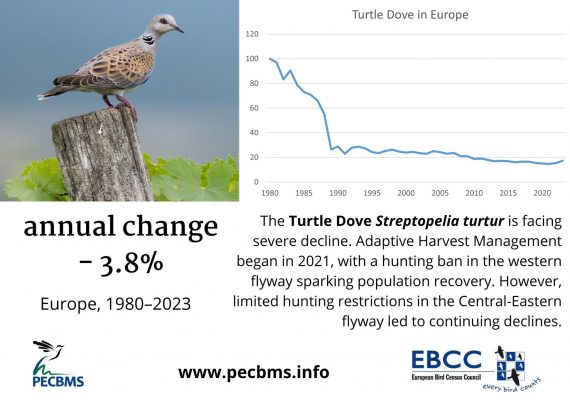
What is new in the 2025 data update?
December 15, 2025
We are grateful to all national coordinators for their efforts to deliver their data by 2024. Although this message is not new, it is very accurate every year.
December 15, 2025
We are grateful to all national coordinators for their efforts to deliver their data by 2024. Although this message is not new, it is very accurate every year.
December 15, 2025
This report presents updated population trends and indices for 170 wild bird species in Europe for the period 1980–2024, produced by the Pan-European Common Bird Monitoring Scheme (PECBMS) in 2025. The report presents species trends over two periods – the long-term period (1980–2024) and the most recent ten years (2015–2024).
December 15, 2025
The Pan-European Common Bird Monitoring Scheme (PECBMS) presents the 2025 update of the European Wild Bird Indices (multi-species indicators), covering the period 1980–2024. The results are based on data for 168 wild bird species collected from 30 European countries.
December 10, 2025
Moldova has transformed bird monitoring by adopting Ornitodata and launching its own national platform, enabling harmonised protocols and integration with European databases. Since 2023, these efforts have standardised data collection and expanded monitoring programs, resulting in over 37,000 observations of 270 species.
October 31, 2025
A major international study led by Dr Kristin Davis, a postdoctoral researcher at UC Berkeley, which also utilised the PECBMS data, has uncovered patterns in how two globally widespread songbirds—the European Starling (Sturnus vulgaris) and the House Sparrow (Passer domesticus)—respond to their environments in native versus non-native ranges.
September 12, 2025
BirdLife Malta has long recognised the importance of systematic bird monitoring. Since its inception in 1962, its members have engaged in a wide range of monitoring activities, including the study of both migratory and resident birds through observations and bird ringing. Notably, the monitoring of Malta’s three breeding seabird species through ringing has been ongoing since the 1960s, making it one of the longest-standing seabird monitoring programmes in the Mediterranean and Europe. Following Malta’s accession to the EU, efforts to establish a standardised breeding bird monitoring programme culminated in the publication of the country’s first Breeding Bird Atlas in 2008.
May 18, 2025
This report summarises the Pan-European Common Bird Monitoring Scheme (PECBMS) activities between 19 September 2024 and 30 April 2025.
April 10, 2025
New research based on the PECBMS data suggests conservation efforts could more effectively identify and protect bird species at greatest risk from climate change by better understanding the range of specific conditions they need to thrive. The study, led by the University of East Anglia (UEA) and co-authorised by scientists from Lisbon University, BTO and CSO, examined the relationship between the extent of the climatic conditions that species tolerate and in which populations are able to survive - known as climatic niche breadth - and their likelihood of declining in response to climate change.
March 13, 2025
We sincerely invite you to the PECBMS workshop, held on 31 March at 3 PM in Riga, Latvia, in the House of Nature of the Academic Centre of the University of Latvia during the EBCC conference Bird Numbers. We bring the complete programme and look forward to meeting many of you.
February 24, 2025
In 2023, the Dutch breeding bird monitoring program had been running for 40 years. The program goes back to the beginning of the previous century when it started with counting nests of conspicuous birds like the Grey heron. Although the fieldwork method (territory mapping) has remained essentially the same since its start in 1984, many aspects regarding the management and implementation of the scheme have changed.








